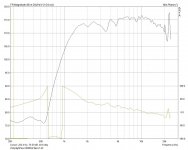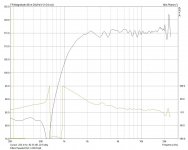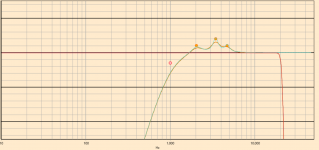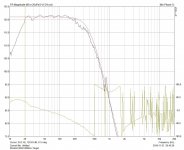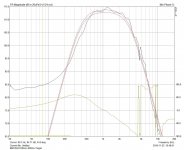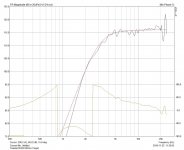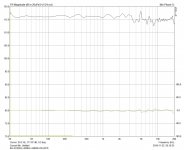At present, just using ARTA for measurements. With HFD couldn't even make sound come out of speakers for measurements.
What appeals to me about HFD is the ability to see what you do graphically (ie as you modify Qs etc)
What appeals to me about HFD is the ability to see what you do graphically (ie as you modify Qs etc)
I would appreciate some help with my BQs especially Qs.
Attached HighPassed Tweeter response with no other filters and Highpassed Tweeter response with "Flattening" Filters applied. They seem to have worked except around the 2K to 4K region. I presume it's my Q's?? as I have guessed them.
At 2,041Hz BoostCut Q=3 Gain+2dB, seems to have worked
At 3,450Hz BoostCut Q=7 Gain+4dB, seems to have created 2 new dips at approx 3K & 3.7K
At 4,725Hz BoostCut Q=7 Gain+2dB, seems to have worked
Any idea what has created the 2 new dips at 3K & 3.7K?
Attached HighPassed Tweeter response with no other filters and Highpassed Tweeter response with "Flattening" Filters applied. They seem to have worked except around the 2K to 4K region. I presume it's my Q's?? as I have guessed them.
At 2,041Hz BoostCut Q=3 Gain+2dB, seems to have worked
At 3,450Hz BoostCut Q=7 Gain+4dB, seems to have created 2 new dips at approx 3K & 3.7K
At 4,725Hz BoostCut Q=7 Gain+2dB, seems to have worked
Any idea what has created the 2 new dips at 3K & 3.7K?
Attachments
OMG, you're flying blind. Respect.
VituixCad lets you sim your filters. It works with biquads. EDIT: you didn't mean biquads, you meant boost/cuts. VC does those too.
VituixCad lets you sim your filters. It works with biquads. EDIT: you didn't mean biquads, you meant boost/cuts. VC does those too.
Is the mic distance to the tweeter exactly the same (mm?) as the previous ones - different distance, different results...
How far away are you measuring distance 10cm = mostly the tweeter, 1,5meter alot of room included?
//
How far away are you measuring distance 10cm = mostly the tweeter, 1,5meter alot of room included?
//
For Tweeter measurement 1m then gated to leave out reflectionsIs the mic distance to the tweeter exactly the same (mm?) as the previous ones - different distance, different results...
How far away are you measuring distance 10cm = mostly the tweeter, 1,5meter alot of room included?
//
Looking at the filters and Q's the dips are not caused by the filters. Also the frequency response >10K seems to be different from the first measurement which is strange if you've only applied these 3 boostcut filters.
Well spotted!!!!!
As I was only concerned about the effect of these BoostCuts, I did not tell you that I had HighShelf2 Freq 15000Hz Q=1.2 Gain +5dB to get rid of slope down.
Well spotted!!!!!
I did not tell you that I had HighShelf2 Freq 15000Hz Q=1.2 Gain +5dB to get rid of slope down.
You're just testing us 😀
Steve, I haven't tried it myself yet but REW is able to automatically generate filters to adjust the measured frequency response to a target frequency response. This might give some ideas on which filters, gain and Q's to be used.
That sounds good if it tells you the filter parameters REW calculate, because I would then have to manually feed the parameters into HFD
I have "flattened" the individual driver responses, 1 to 1.5 Octaves from XO freq, with my limited knowledge of Q's
I have included the phase plots and Target curves
Added the definitive XOs Gains and Delays
The final plot with all drivers, best I could do. Plotted at 1/24 Octave smoothing. Looks a lot better at 1/1
If anyone can see improvements, would much appreciate.
The Mid only, looks strange as with to 2 XOs dosen't seem to have a chance to be flat
The plot of all drivers together, the tweeter develops a peak at around 5K which wasn't so large when tweeter measured by itself.
I have included the phase plots and Target curves
Added the definitive XOs Gains and Delays
The final plot with all drivers, best I could do. Plotted at 1/24 Octave smoothing. Looks a lot better at 1/1
If anyone can see improvements, would much appreciate.
The Mid only, looks strange as with to 2 XOs dosen't seem to have a chance to be flat
The plot of all drivers together, the tweeter develops a peak at around 5K which wasn't so large when tweeter measured by itself.
Attachments
As this is as far as I go, I hope I have thanked everybody who has been interested and helped me with their knowledge. I think that I have thanked all except kimmosto and Peter (PLB) so I want to thank you two too!
I'm just starting and was able to do some measurements in HFD but did not find a way to combine near- and farfield measurements. There is a possibility to import measurements, did you look at that?
What I found usefull in HFD (4.9) is the possibility to set a flat frequency response. This way you can visualize different filters, Q factors etc.
I have not mastered HFD at all. Find the instruction useless.
The way I combined the near and farfiled is by seeing where the measurements overlapped. This enabled me to set the gains for woofer and mid so that the response was almost flat.
I will reread the HFD manual as setting the flat frequency response interests me.
Are you happy with the end result now? Does it sound great?
Fedde
Hi
Yes it sounds very good. It looks a lot better on paper now. But what is important is the sound of course.
I will test it out with my best recordings this weekend. I had such a good Passive system (with the same drivers) that it is difficult to notice the difference.
Are you happy with the end result now? Does it sound great?
Fedde
Tested with good recording.
Yes it sounds great
Cool. Do you think it surpasses the passive configuration now?
Fedde
Yes, better. Sounds clearer more natural.
But was it worth it? I now have 6channel DSP and 6 amps.
- Home
- Loudspeakers
- Multi-Way
- Freq measurements and Hypex Filter Design adjustments
